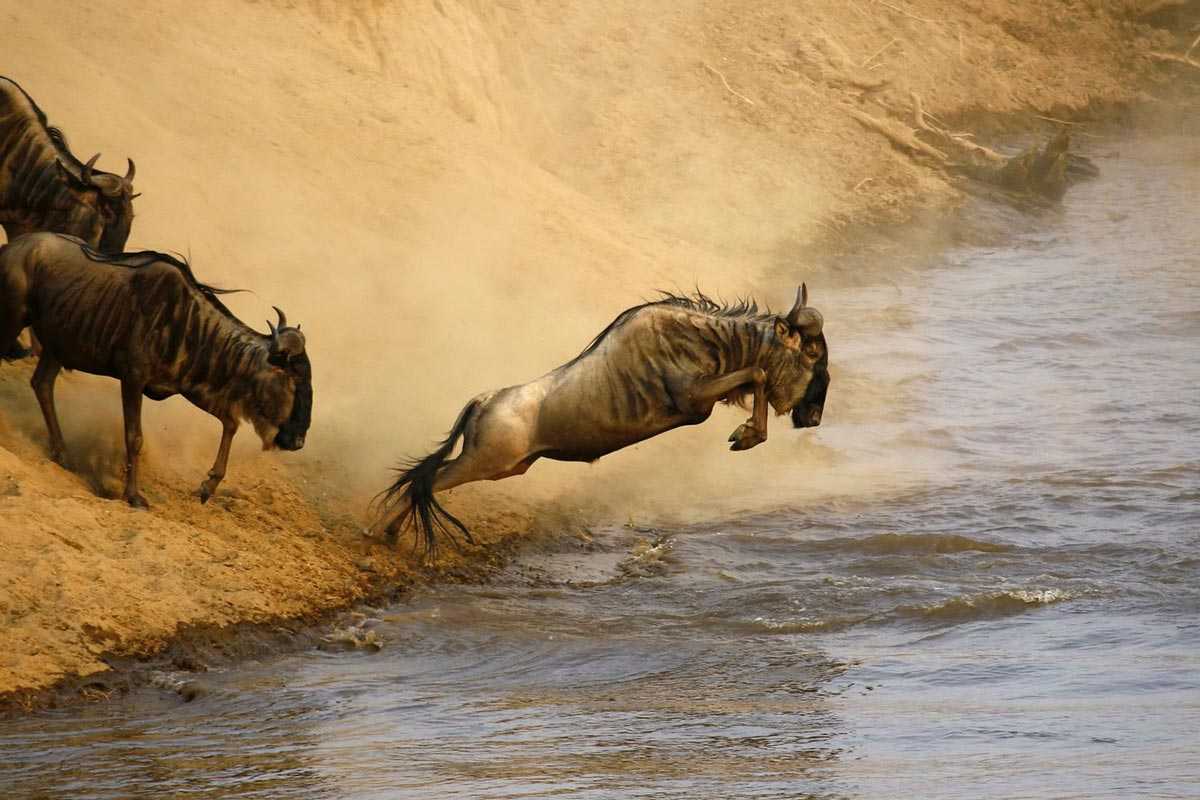Let us set the scene for you: 2 million wildebeest, accompanied by zebra and gazelle, making their way across the vast, endless plains of the Serengeti National Park and the Maasai Mara Reserve in their search for more plentiful food and water supplies. This is the magnificent Great Migration and it’s the largest mass movement of land mammals on the planet. Providing one of the best safari opportunities in the world, this is the greatest wildlife spectacle on earth.
Who and what?
The Great Migration sees massive numbers of mainly wildebeest (with zebra and gazelle straggling along) making their way to greener pastures from the Serengeti in Tanzania to the Masai Mara of Kenya. Their journey takes them on a circular over 2000km and across diverse landscapes that include volcanic grasslands, rocky outcrops, thick forests and dangerous rivers. Needless to say, the odyssey is as perilous as it is exhilarating, with some 250 000 wildebeest perishing en route.

Interesting fact: Wildebeest and zebra graze in harmony because they prefer different parts of the grasslands – the wildebeest like the fresh shoots while the zebra like the longer grasses.
Why?
As the seasons change, the once rain-ripened, abundant grazing areas become depleted and the herds have no choice but to move on in search of better grazing options.
Where and when?
Because of the mobile nature of the Migration as well as the rains, the exact timings vary every year. The herds you see will depend on your location and the time of year you’re visiting. This is a rough guide by month to help you plan your visit.
January – March
The annual rains hit the plains of the Serengeti and the Ngorongoro Conservation, producing lush grazing areas. It’s during this time that the female wildebeest birth their calves. Roughly 400 000 wildebeest are born during a two to three week period and these babies are born to run – mere minutes after entering the world, they’re already off alongside their mothers.
April – May
The grasslands are dwindling and the herds are forced to start making tracks in search of better grazing. They move northwards towards the Maasai Mara (usually along the Serengeti’s Western Corridor).
June – July
Movement continues north and mating season begins. The first big river crossing takes place now: the Grumeti River. Strong currents and deep patches increase the risk of the wildebeest drowning and many do. There’s also the added threat of plenty of crocodiles who lay in wait, ready to attack.

August
The herds make their way into Kenya as their search for verdant grasslands continues. Before reaching the Maasai Mara there’s one more intense river crossing at the Mara River. Again, fraught with danger, the wildebeest plough on, hoping to make it safely out the other side.
September – November
The plains are brimming with large herds which attracts a range of predators. Lion, cheetah and leopard prowl nearby as well as wild dog and hyena. There’s no guarantee that you’ll see a kill but your chances are relatively high.
November – December
Once again, the annual rains begin down south, signalling the herds to begin their great trek back down to the plains of the Serengeti. The circle is complete once they arrive back at the Serengeti just in time for calving season, at which point the migration process begins again.
Good to know: Calving season is actually the best time to witness a kill as the predators like to take advantage of defenseless young.

Strictly speaking, June to October is the main tourist season with many travellers flocking to see the dramatic river crossings, but the constant movement means you have plenty of opportunity in other months to witness the spectacle.
Itineraries we recommend:
Western Tanzania Safari and Chimpanzees
Portfolio Journeys can tailor-make your once-in-a-lifetime trip to East Africa. Get in touch and let us help you plan your trip to see this incredible feat of nature.
Photo creds:






